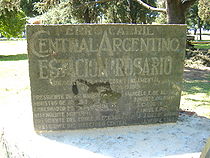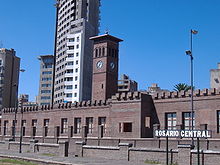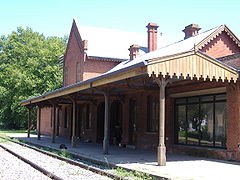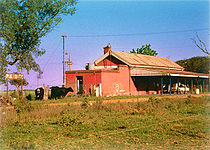
Central Argentine Railway
Encyclopedia

Indian gauge
Indian gauge is a track gauge commonly used in India, Pakistan, Bangladesh, Sri Lanka, Argentina and Chile. It is also the gauge that is used on BART , in northern California.- Scotland :...
, , British-owned companies that built and operated railway networks in Argentina
Argentina
Argentina , officially the Argentine Republic , is the second largest country in South America by land area, after Brazil. It is constituted as a federation of 23 provinces and an autonomous city, Buenos Aires...
. The company was established in the 19th century, to serve the provinces
Provinces of Argentina
Argentina is subdivided into twenty-three provinces and one autonomous city...
of Santa Fe
Santa Fe Province
The Invincible Province of Santa Fe, in Spanish Provincia Invencible de Santa Fe , is a province of Argentina, located in the center-east of the country. Neighboring provinces are from the north clockwise Chaco , Corrientes, Entre Ríos, Buenos Aires, Córdoba, and Santiago del Estero...
and Córdoba
Córdoba Province (Argentina)
Córdoba is a province of Argentina, located in the center of the country. Neighboring provinces are : Santiago del Estero, Santa Fe, Buenos Aires, La Pampa, San Luis, La Rioja and Catamarca...
, in the east-central region of the country.
Origins

Government of Argentina
The government of Argentina, functioning within the framework of a federal system, is a presidential representative democratic republic. The President of Argentina is both head of state and head of government. Executive power is exercised by the President. Legislative power is vested in both the...
granted the company, led by engineer William Wheelwright
William Wheelwright
William Wheelwright was a businessman who played an essential role in the development of steamboat and train transportation in Chile and other parts of South America...
, a concession to build and exploit a railway line between the cities of Rosario
Rosario
Rosario is the largest city in the province of Santa Fe, Argentina. It is located northwest of Buenos Aires, on the western shore of the Paraná River and has 1,159,004 residents as of the ....
(a major port
Port of Rosario
The Port of Rosario is an inland port and a major goods-shipping center of Argentina, located in the city of Rosario, province of Santa Fe, on the right-hand shore of the Paraná River, about 550 km upstream from the Atlantic Ocean.-Overview:...
in southern Santa Fe, on the Paraná River
Paraná River
The Paraná River is a river in south Central South America, running through Brazil, Paraguay and Argentina for some . It is second in length only to the Amazon River among South American rivers. The name Paraná is an abbreviation of the phrase "para rehe onáva", which comes from the Tupi language...
) and Córdoba
Córdoba, Argentina
Córdoba is a city located near the geographical center of Argentina, in the foothills of the Sierras Chicas on the Suquía River, about northwest of Buenos Aires. It is the capital of Córdoba Province. Córdoba is the second-largest city in Argentina after the federal capital Buenos Aires, with...
(a large city near the geographical center of Argentina, and the capital of the province of the same name). The grant included a clause to populate the lands along and around the railway that were given to the company by the national state.
The construction works started in April 1863 with the establishment of the terminus in Rosario, at Rosario Central Station. The line, a broad gauge
Broad gauge
Broad-gauge railways use a track gauge greater than the standard gauge of .- List :For list see: List of broad gauges, by gauge and country- History :...
railway, progressed westward, reaching Córdoba in 1870, covering a total of 396 km. It was the longest in Argentina at the time, and the first to join two provinces.
The company sent a commissioner to Europe to bring immigrants
Immigration to Argentina
Immigration in Argentina, can be divided in several major stages:* Spanish colonization starting in the 16th century, integrating the indigenous inhabitants ....
to form agricultural colonies
Agricultural colonies in Argentina
Agricultural colonies in Argentina were a demographically and economically important part of the evolution of the country. The Argentine government, faced with large areas of fertile land that were unpopulated or settled by aboriginal tribes , encouraged European immigration, welcoming settling...
, as required by the concession contract. They were settled first in Roldán
Roldán, Santa Fe
Roldán is a small city in the , located within the metropolitan area of Greater Rosario. According to the 2001 census, it had a population of 11,470 inhabitants...
, the first stop after Rosario, and then in San Lorenzo
San Lorenzo, Santa Fe
San Lorenzo is a city in the south of the province of Santa Fe, Argentina, located 23 km north of Rosario, on the western shore of the Paraná River, and forming one end of the Greater Rosario metropolitan area...
, Carcarañá
Carcarañá
Carcarañá is a city in the , located in the San Lorenzo Department, on the southern banks of the Carcarañá River, west of Rosario on National Route 9, and south of the provincial capital...
, Cañada de Gómez
Cañada de Gómez
Cañada de Gómez is a city in the . It is the head town of the Iriondo Department and is located about west of Rosario and from the provincial capital, on National Route 9. It has a population of about 30,000 inhabitants ....
and Tortugas.
Progress

The CA absorbed a local company, Ferrocarril Oeste Santafesino (F.C.O.S), in 1900. The lines handled by F.C.O.S., which served the southwest of Santa Fe Province and the south of Córdoba (up to the city of Cruz Alta
Cruz Alta
Cruz Alta may refer to:*Cruz Alta, Córdoba Province, Argentina*Cruz Alta Department, Tucumán Province, Argentina*Cruz Alta, Rio Grande do Sul, Brazil...
), were merged with those of the larger company, and the passenger services handled by Rosario Oeste Santafesino Station were transferred to Rosario Central Station, while the former was renamed Rosario Este.
In 1908, CA was merged with another company, Buenos Aires and Rosario Railway
Buenos Aires and Rosario Railway
The Buenos Aires and Rosario Railway was a British-owned railway company that built and operated a broad gauge railway network in Argentina, where it was known as the Ferrocarril Buenos Aires y Rosario....
, which served the Buenos Aires
Buenos Aires
Buenos Aires is the capital and largest city of Argentina, and the second-largest metropolitan area in South America, after São Paulo. It is located on the western shore of the estuary of the Río de la Plata, on the southeastern coast of the South American continent...
–Rosario line. The passenger services were unified and optimized: Rosario Central Station was left in charge of short and mid-distance services, while Rosario Norte Station
Rosario Norte Station
The Rosario Norte Railway Station is a train station in Rosario, province of Santa Fe, Argentina. It is located on Aristóbulo del Valle Avenue, at the junction with Callao St., north of the city center, in the neighbourhood known as Barrio Pichincha....
was set aside for long-distance and express services. The fused company opened two new stops in Rosario, Parada Cruce Alberdi (present-day Patio Parada
Patio Parada
Patio Parada is a rail yard in Rosario, province of Santa Fe, Argentina. It is an important part of the railway system of the city and has been designed as the future site of a multi-modal public transport terminus. Formerly belonging to the Ferrocarril General Bartolomé Mitre company, it is now...
) in the north-center of the city, and Parada Golf (or Parada Links), in the western limit of the municipality, near today's Rosario Golf Club.
The company continued to expand. Between 1935 and 1940, already past the "golden age" of Argentine railways, Rosario Central Station managed seventy daily train services, with an annual average of 438,000 passengers.

Nationalisation
British railway companies operating in Argentina, including CA, were nationalisedRailway Nationalisation in Argentina
In 1948, during President Juan Perón’s first term of office, the seven British-owned and three French-owned railway companies then operating in Argentina, were purchased by the state...
in 1948 by the Juan Perón
Juan Perón
Juan Domingo Perón was an Argentine military officer, and politician. Perón was three times elected as President of Argentina though he only managed to serve one full term, after serving in several government positions, including the Secretary of Labor and the Vice Presidency...
administration. Ferrocarril Central Argentino, took over the northern section of Ferrocarril Rosario y Puerto Belgrano
Ferrocarril Rosario y Puerto Belgrano
The Ferrocarril Rosario y Puerto Belgrano was a French-owned railway company which operated a broad gauge, , single track line between the cities of Rosario and Puerto Belgrano in Argentina...
and then became part of the state-owned Ferrocarril General Bartolomé Mitre
Ferrocarril General Bartolomé Mitre
Ferrocarril General Bartolomé Mitre , named after the former Argentine president Bartolomé Mitre, was one of the six state-owned Argentine railway companies formed after President Juan Perón's nationalisation of the railway network in 1948...
. The railway system as a whole was reconfigured and this meant the closure of many stations; in the case of the Ferrocarril Mitre, only the original Rosario Central Station was left to handle passengers.

